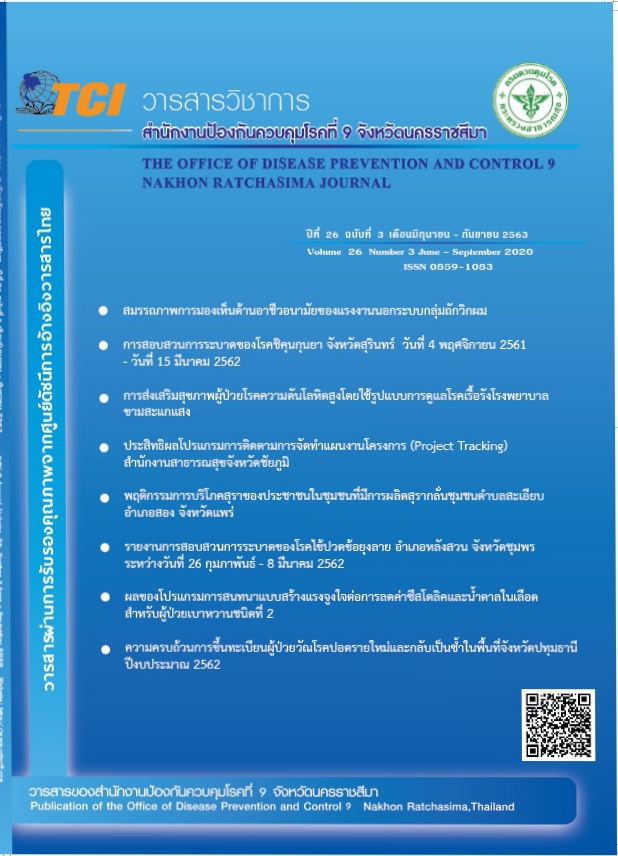Investigation of a Mosquito-Borne Chikungunya Fever Outbreak in Langsuan District, Chumphon: February 26 - March 8, 2019
Keywords:
Chikungunya disease, disease control, disease preventionAbstract
At 10.00 a.m. on February 26, 2017, the Paknam Langsuan Subdistrict Municipality Center sent notification that five patients had attended a clinic in the subdistrict presented with a fever and a rash to the Division of Communicable Disease Control, Primary and Holistic Care Department, Paknam Langsuan Hospital and the Division of Communicable Disease Control, Langsuan District Public Health Office. The patients had a fever, chill, join pain, malaise, and rashes. The Langsuan District’s Surveillance and Rapid Response Team (SRRT) commenced a disease investigation the same day at 01.00 p.m. to describe the outbreak characteristics of the mosquito-borne Chikungunya Fever in Langsuan District, Chumphon, Thailand, regarding the local population, location, and event chronology. The study focused on discovering the outbreak cause, the contact characteristics of the disease, and an analysis of the disease risk factors to control and prevent further outbreaks. A descriptive epidemiological study was conducted. The results reveal that 55 patients had Chikungunya fever symptoms in Langsuan district in the period January 1 - March 3, 2019. Of these, 45 were suspected cases, 8 probable cases, and 2 confirmed cases. Most cases were in the age group of < 20 years (36.40%) and were identified as either students, agricultural workers, or other employees. The outbreak model was a propagated source, and the disease risk factor is the topography of Langsuan District, which is a flat area in southern Thailand on the coast of the Gulf of Thailand. This area experiences regular precipitation throughout the year, and stagnant water collects in plains or basins which serve as breeding grounds for the disease-carrying Aedes Aegypti mosquito species. The source of the disease is mosquito larvae which are found in local houses, but the search for exposure to the disease extended to other communal areas and schools. Measures implemented to control and prevent the spread of the disease outbreak included spraying mosquitos, eliminating mosquito larvae, providing health education, advising people of self-protection measures, educating people about the associated with fever, and recommending personal care following symptoms of the disease. After the outbreak control and prevention measures extended beyond the surveillance period, had not found the patients to match the definition of the disease by the end of March 2019. In the long-term, recommendations for timely and effective disease control include creating a surveillance system, rapid control and disease prevention, and prompt notification of news of an outbreak.
References
2. งานระบาดวิทยา. รายงานจำนวนผู้ป่วยโรคไข้ปวดข้อยุงลาย ปี พ.ศ.2557 – 2563. วันที่ 27 กุมภาพันธ์ 2563; สำนักงานสาธารณสุขอำเภอหลังสวน. ชุมพร; 2563. หน้า 1.
3. สำนักงานจังหวัดชุมพร. อำเภอหลังสวน [อินเทอร์เน็ต]. 2556 [เข้าถึงเมื่อวันที่ 25 กุมภาพันธ์ 2563]. เข้าถึงได้จาก http://www.chumphon.go.th/2013/page/ampher_langsuan/lang/1.
4. พจมาน ศิริอารยาภรณ์, ลักษณา ไทยเครือ. การสอบสวนทางระบาดวิทยา. ใน: คำนวณ อึ้งชูศักดิ์ ปฐม สวรรค์ปัญญาเลิศ, วิทยา สวัสดิวุฒิพงศ์, ชุลีพร จิระพงษา, บรรณาธิการ. พื้นฐานทางระบาดวิทยา.
พิมพ์ครั้งที่ 3. กรุงเทพมหานคร: โรงพิมพ์แคนนากราฟฟิค; 2562: 178 – 211.
5. กรมควบคุมโรค กระทรวงสาธารณสุข. แผนงานเฝ้าระวัง ป้องกัน และควบคุมโรคติดต่อนำโดยยุงลาย ปี 2560-2564 [อินเทอร์เน็ต]. 2563 [เข้าถึงเมื่อวันที่ 27 เมษายน 2563]. เข้าถึงได้จาก http://plan.ddc.moph.go.th/meeting30_1augsep/meetting30_1/page1.html.
6. สำนักระบาดวิทยา กรมควบคุมโรค กระทรวงสาธารณสุข [อินเทอร์เน็ต]. 2563 [เข้าถึงเมื่อวันที่ 27 เมษายน 2563]. เข้าถึงได้จาก http://www.boe.moph.go.th/fact/Chikungunya.htm.
7. สริตา มิ่งมาลีโชคชัย. การแพร่ระบาดของโรคชิคุนกุนยาช่วง พ.ศ.2552 -2560 ในประเทศไทย. [วิทยานิพนธ์ปริญญาวิทยาศาสตรบัณฑิต]. พิษณุโลก: มหาวิทยาลัยนเรศวร; 2561.

Downloads
Published
How to Cite
Issue
Section
License
บทความที่ลงพิมพ์ในวารสารวิชาการสำนักงานป้องกันควบคุมโรคที่ 9 จังหวัดนครราชสีมา ถือว่าเป็น
ลิขสิทธิ์ สำนักงานป้องกันควบคุมโรคที่ 9 จังหวัดนครราชสีมา



